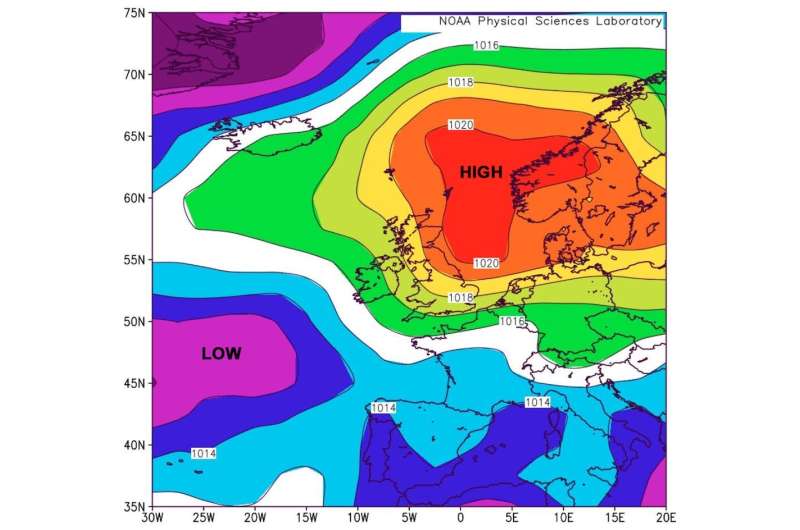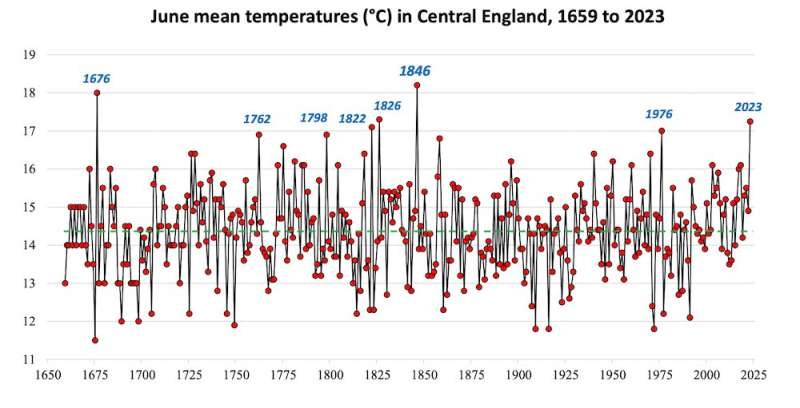This article has been reviewed according to Science X's editorial process and policies. Editors have highlighted the following attributes while ensuring the content's credibility:
fact-checked
trusted source
written by researcher(s)
proofread
June 2023 was the hottest in England since 1846: Here's why it was so unusual

Warm or hot weather was persistent in the UK throughout most of June 2023, with temperatures peaking at 32°C in parts of south-east England. Although well short of last July's record 40°C, for large parts of England the last time June was this hot was in 1846—almost 180 years ago.
The Met Office keeps a detailed national and regional temperature database extending back to 1884, and 2023 now appears certain to claim the title for the hottest June during that period for the whole of the UK.
There are too few reliable long-term temperature records to extend the series to the whole of the UK prior to 1884, and before that scientists rely on a composite regional database known as the Central England Temperature series, or CET. The CET series draws on records from a roughly triangular area bounded by Lancashire, London and Bristol.
This temperature series starts in 1659 and was originally compiled by Cambridge climatologist Gordon Manley in 1953. It is the longest instrumental temperature record in the world, and is updated monthly by the Met Office Hadley Center in Exeter. June's provisional mean CET looks to be around 17.2°C or 17.3°C, which is about 2.5°C hotter than the norm over the most recent 30-year period.
There are two main reasons why June 2023 was so warm in the UK. First, sea surface temperatures in the north Atlantic and around the British Isles have been at record or near-record highs in recent weeks. Winds blowing from almost any direction passed over warmer-than-normal seas and so were likely to arrive warmer than normal too.
Second, June was dominated by slow-moving (or "blocked") high-pressure systems sitting over or a little to the east of Britain and Ireland. This led to long spells of settled, dry weather. And with the sun at its highest elevation in the year, plentiful sunshine meant temperatures rose quickly.
Hot Junes were rare during the last 150 years
It may be a surprise to discover in this era of increasing temperatures as a result of fossil-fuel driven climate change that there have been even hotter Junes than 2023—quite a bit hotter too. For some reason, very warm or hot Junes have been almost absent within the last 150 years, although they were much more common up to the middle of the 19th century.
June 1846 still tops the CET table with a mean temperature of 18.2°C. You have to go back another 170 years to find one as hot, June 1676, when temperatures averaged 18.0°C. Seventeenth-century temperature records are fewer and subject to greater uncertainty than later periods, so this might be a few tenths of a degree out in either direction.

After 1846 and 1676 comes June 1826 with a mean temperature of 17.3°C, and then June 1822 (17.1°C). June 2023 looks to be in the same territory. The next three hottest Junes tie with a mean CET of 16.9°C: 1762, 1798 and 1976.
That last entry was the most recent in the top ten of all-time hottest Junes until this year. It was the start of the outstandingly hot and dry summer of 1976. June temperatures that year were actually fairly close to average until an exceptional hot spell set in during the closing week. Hot, dry and sunny weather then persisted with little interruption until the end of August.
In contrast, although no new records for extreme temperatures were set, temperatures in June 2023 surpassed 30°C fairly widely mid-month, even as far north as Cumbria. The last time such high temperatures were reached before mid-June was back in 1996.
June 2023 was also sunny in most places, although less so on east and north-east coasts where sea fogs were persistent. Up to June 29, Bournemouth Airport on the south coast of England had recorded 292 hours of sunshine, an average of over ten hours per day, with one still to count. The long-term June average there is 230 hours (seven-and-a-half hours per day).
The month was also dry or very dry in most places. In parts of East Anglia, June rainfall has been less than a third of normal. These conditions led to some hosepipe bans in south-east England. Without substantial rainfall, further water restrictions seem likely in other areas before too long.
Will temperatures remain high in July?
And what of the rest of summer—is a pleasant June all we can expect? What clues can we glean from previous hot Junes?
Of the months with the highest June mean temperature (1676, 1762, 1798, 1822, 1826, 1846 and 1976), only the summers of 1826 and 1976 remained hot. July 1762 was hotter than June, but August was cool, while summers in the other years were mostly a little warmer than normal, but not as warm as June.
So, if the historical record is anything to go by, we may have already seen the hottest weeks of summer 2023. Of course, the rest is up to Mother Nature.
Provided by The Conversation
This article is republished from The Conversation under a Creative Commons license. Read the original article.![]()

















